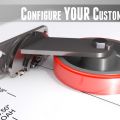Getting the most out of the right heavy duty casters
There is more to choosing heavy duty casters then just picking out ones with the right weight bearing rating. Different sizes of caster can support the same amount of weight, but how they are engineered can affect how well you can move the transport trolley. Here is a basic overview about what you should be considering before buying your casters.
Measuring the caster
Casters are measured in three ways. You want to know the base mount size; this is the plate at the top of the caster that attaches to the transport unit. Then you want to know the width of the caster, which will tell you what size wheel you can fit on it. The size of the wheel is a combination of the diameter (to allow for clearance under the caster base), and the width at the axle point. The last measurement is the overall height of the caster with the wheel installed. Be careful to remember to measure this as it affects the overall height of the loaded transport unit.
Making sure the base mount is right
This is where many people run into a problem. There is a bit more to making sure you have the right base mount than just making sure bolt holes line up. Heavy duty casters can still come with a variety of load weight capacity base mounts. The thickness of the base plate, the arrangement of the bolt holes and the size of bolt or screw attachments are all going to make a difference in how much your caster can handle. The general rule of thumb is that the caster with the greatest capacity is going to have a bent plate with a pass through bolting connection. This means that the plate is spreading the weight and force of movement in multiple directions to reduce overall strain.
Selecting the right wheel type
There are two different types when it comes to wheels – the wheel composition type, and the wheel arrangement type. Wheel arrangement refers to whether or not your caster is a single, twin or v-groove style. The wheel composite refers to whether the wheel is made of metal, plastic, polyurethane or rubber. The heavier the duty of the wheel, the more likely it is to be made of rubber or metal. V-groove style wheels, which combine metal and polyurethane, are also considered to be heavy-duty wheels.
Making sure your caster promotes stable load handling
Just putting heavy duty casters on your transport unit isn't going to be enough to ensure stable load handling. The first thing that you have to look at is whether or not the transport unit is capable of handling the load type. Don't try to upgrade the load capacity of a trolley by adding heavier casters, and don't try to use heavier casters as a means to fix a trolley that should be replaced. Once you are sure that your casters and trolley are well matched to transport the intended load weight, stability will improve. If you are still having issues, you may want to go back and reconsider the wheel type and switch to a twin wheel caster design.
For More Info About Heavy duty casters
Source : Click Here



